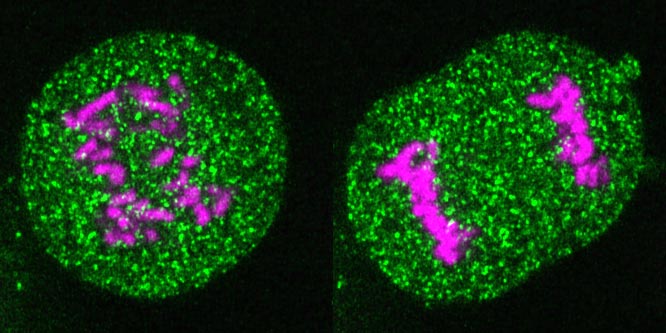Cell division: cleaning the nucleus without detergents

Images of a live HeLa cell expressing fluorescent GEM particles (green) to probe the localization of large cytoplasmic components during cell division. Chromosomes are fluorescently labelled in magenta. During early stages of mitotic exit (image on the left side), chromosomes are still far apart, and GEM particles localize throughout the cell and also in spaces between chromosomes. Later in mitosis, as the chromosomes move towards the cell poles, they come together to form a dense cluster (image on the right side). During this clustering process, the GEM particles are excluded from the space between chromosomes. The nuclear envelope, which subsequently wraps around chromosomes then does not incorporate cytoplasmic GEMs and potentially other cytoplasmic contaminants. ©Gerlich lab/IMBA
A team of researchers, spearheaded by the Gerlich lab at IMBA, has uncovered how cells remove unwanted components from the nucleus following mitosis. The results, published in the journal Nature, stem from a fruitful collaboration between the Gerlich lab and former IMBA Postdoc Sara Cuylen-Häring, who recently established her own group at EMBL.
Organization of cells into specific compartments is critical for their function. For instance, by separating the nucleus from the cytoplasm, the nuclear envelope prevents premature translation of immature RNAs. During mitosis, however, the nuclear envelope disassembles, allowing large cytoplasmic components such as ribosomes to mix with nuclear material. When the nuclear envelope reassembles following mitosis, these cytoplasmic components must once again be removed. “The nuclear envelope can contribute to this by actively importing or exporting substrates up to a certain size, but it was not clear what happens with very large cytoplasmic components”, says Mina Petrovic, PhD student in the Gerlich lab and joint first author of the study.
The research team from IMBA and EMBL have now shown that large components such as ribosomes are in fact removed from the forming nucleus before the nuclear envelope is assembled again. This exclusion process requires the protein Ki-67, which was the focus of an earlier publication in Nature by Sara Cuylen-Häring, the other joint first author of this study, when she was a postdoc in the Gerlich lab in 2016. Dr Cuylen-Häring explains: “We previously showed that Ki-67 was responsible for keeping chromosomes separate in early stages of mitosis by acting as a surfactant. Remarkably, we have now found that it changes its properties at the end of mitosis and performs the opposite function, namely clustering of chromosomes. By coming together into a dense cluster at the end of cell division, chromosomes are able to exclude large cytoplasmic components before the nuclear envelope reforms.”
This important work shows how a single protein can dynamically change the material properties of cellular components to regulate compartmentalization of key processes within the cell.
About IMBA
IMBA – Institute of Molecular Biotechnology – is one of the leading biomedical research institutes in Europe focusing on cutting-edge stem cell technologies, functional genomics, and RNA biology. IMBA is located at the Vienna BioCenter, the vibrant cluster of universities, research institutes and biotech companies in Austria. IMBA is a subsidiary of the Austrian Academy of Sciences, the leading national sponsor of non-university academic research. The stem cell and organoid research at IMBA is being funded by the Austrian Federal Ministry of Science and the City of Vienna.
www.imba.oeaw.ac.at
About EMBL
EMBL is Europe’s flagship laboratory for the life sciences. Established in 1974 as an intergovernmental organisation, EMBL is supported by over 20 member states.
EMBL performs fundamental research in molecular biology, studying the story of life. The institute offers services to the scientific community; trains the next generation of scientists and strives to integrate the life sciences across Europe.
EMBL is international, innovative and interdisciplinary. Its more than 1600 staff, from over 80 countries, operate across six sites in Barcelona (Spain), Grenoble (France), Hamburg (Germany), Heidelberg (Germany), Hinxton (UK) and Rome (Italy). EMBL scientists work in independent groups and conduct research and offer services in all areas of molecular biology.
EMBL research drives the development of new technology and methods in the life sciences. The institute works to transfer this knowledge for the benefit of society.
Wissenschaftliche Ansprechpartner:
Science Communications Contacts: IMBA caterina.purini@imba.oeaw.ac.at; EMBL mathias.jaeger@embl.org
Originalpublikation:
Original Publication: Cuylen-Haering, Petrovic et al.,’Chromosome clustering by Ki-67 excludes cytoplasm during nuclear assembly’, Nature, 2020 doi 10.1038/s41586-020-2672-3
Media Contact
All latest news from the category: Life Sciences and Chemistry
Articles and reports from the Life Sciences and chemistry area deal with applied and basic research into modern biology, chemistry and human medicine.
Valuable information can be found on a range of life sciences fields including bacteriology, biochemistry, bionics, bioinformatics, biophysics, biotechnology, genetics, geobotany, human biology, marine biology, microbiology, molecular biology, cellular biology, zoology, bioinorganic chemistry, microchemistry and environmental chemistry.
Newest articles

An Endless Loop: How Some Bacteria Evolve Along With the Seasons
The longest natural metagenome time series ever collected, with microbes, reveals a startling evolutionary pattern on repeat. A Microbial “Groundhog Year” in Lake Mendota Like Bill Murray in the movie…

Witness Groundbreaking Research on Achilles Tendon Recovery
Achilles tendon injuries are common but challenging to monitor during recovery due to the limitations of current imaging techniques. Researchers, led by Associate Professor Zeng Nan from the International Graduate…

Why Prevention Is Better Than Cure—A Novel Approach to Infectious Disease Outbreaks
Researchers have come up with a new way to identify more infectious variants of viruses or bacteria that start spreading in humans – including those causing flu, COVID, whooping cough…



